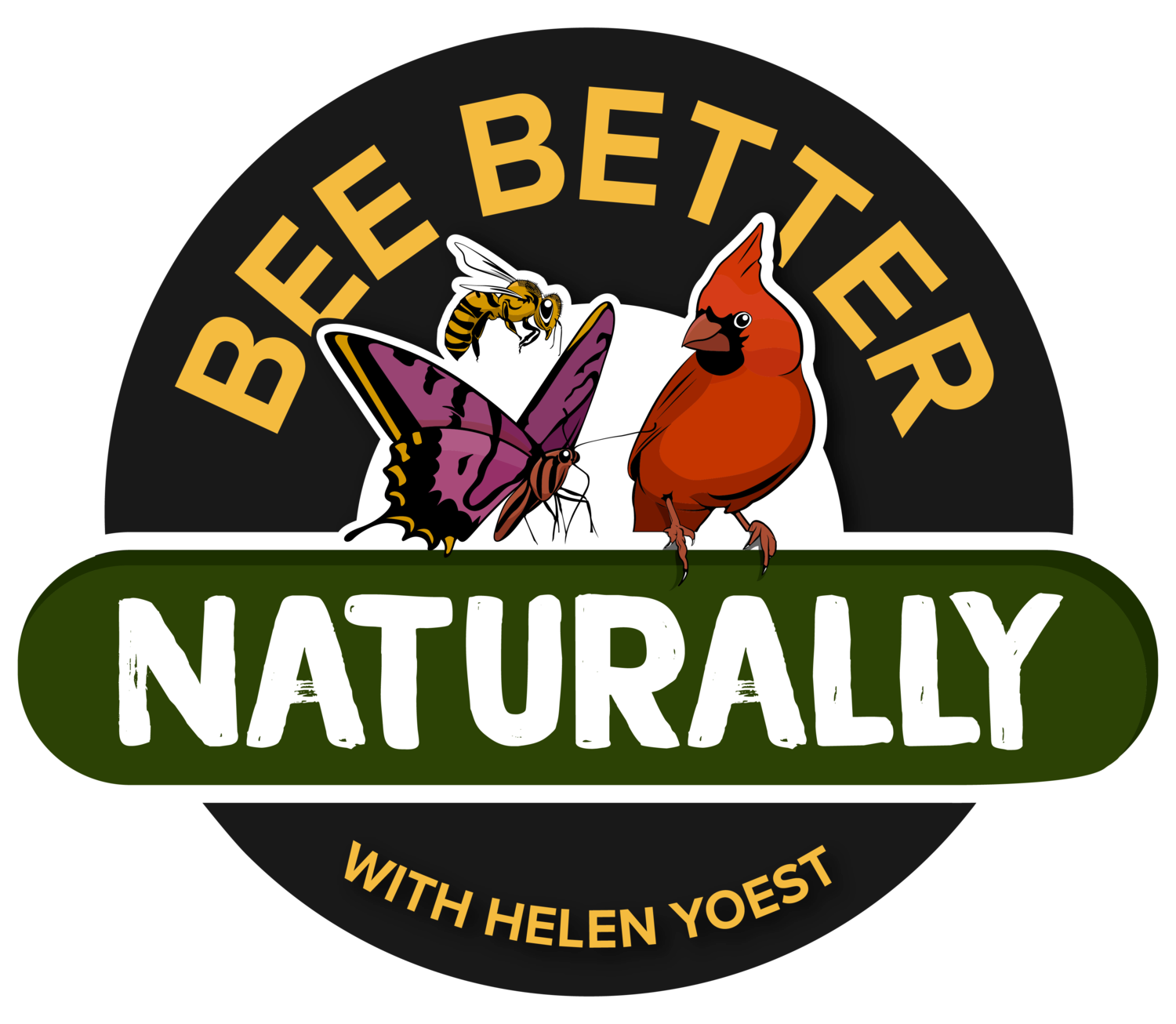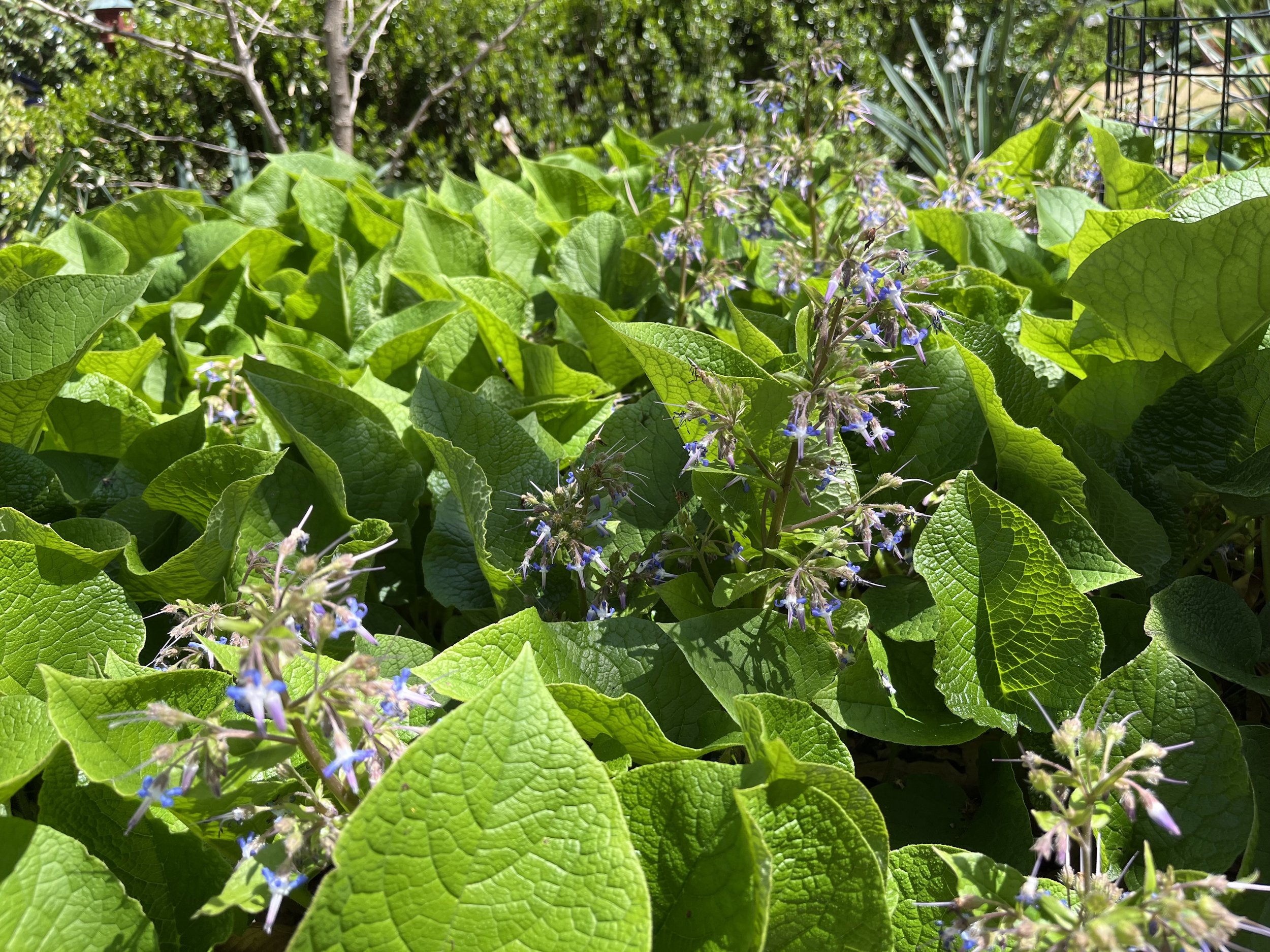The BBN mailbox garden., with thread leaf amsonia, Amsonia hubrichtii
Our area pines release pollen for reproduction, coating every surface with yellow dust. We need to appreciate the spring flowers. But first, wear rose-colored glasses and pray for a cleansing rain.
Let’s begin with the mixed border, the most visible bed off the back-covered porch. The mixed border is a water-wise transitional zone, meaning it only needs supplemental water after three to four weeks without rain.
Native Columbine
Photo Credit: Liz Condo. Native Columbine, Aquilegia canadensis.
As it stands tall, the most notable plant this April is our native columbine, Aquilegia canadensis. On the east coast, it is said the ruby-throated hummingbird’s arrival coincides with the flowering of the wild columbine. Hummers need early nectar to refuel from their long migration.
Green and Gold
Photo Credit: Liz Condo. Native green and gold, "Eco Lacquered, Spider’, Chrysogonum virginianum var. australe 'Eco Lacquered Spider'
I think the straight species of green and gold, Chrysogonum virginianum, has brighter colors and is prettier than the cultivar Chrysogonum australe 'Eco Lacquered Spider’—a (very) fast-growing spreader. Maybe it seems duller from the yellow coating of pine sex. For reasons unknown, I’ve never been able to establish the straight species. I’ve tried several times. ‘Eco Lacquered Spider’ green and gold seem to thrive in the mixed border, but maybe too much.
Photo Credit: Helen Yoest. Dominatrix Jack-in-the-Pulpit Arisaema Thunbergii or thunbergii ssp. Urashima subsp urashima
Dominatrix Jack-in-the-Pulpit Arisaema Thunbergii or thunbergii ssp. Urashima subsp urashima is kind of a fancy native plant; I don’t tend to choose plants for their funkiness. Rather, I choose based on pollinators. And who are the pollinators? Flies and fungus gnats. OK, maybe I didn’t choose the plant for that reason. Both flies and fungus gnats are attracted to the plant’s slight fungal odor, becoming trapped within the spathe and eventually escaping with pollen on their little bodies. Their sightings bring me joy each spring—the flower, not the flies or gnats! This unique plant can change sex. Starting as a male, it can spontaneously change to a female the next year and back again as a male the following year.
Lilac
By the time Liz Condo came to photograph the flowers, they were no longer in bloom, and I was remiss in getting a photo.
When I first moved to Raleigh in 1988 and into our 1905 historic home in the Oakwood neighborhood, I inherited a common lilac shrub, Syringa vulgaris. I loved it, but was surprised it was doing so well since lilacs prefer cooler climates within the hardiness zones 3 to 7.
At the time, we were in hardiness zone 7. It thrived for a few years, and then I lost it. Now Raleigh is in zone 8a. Years after I moved to my current home, I tried the lilac Syringa × 'Boomerang Purple'. It’s doing very well. Even though the hardiness zones are the same, I haven’t lost 'Boomerang' yet. It’s called ‘Boomerang’ because it’s a reblooming variety.
Spanish Bluebells
Photo Credit: Liz Condo. Spanish bluebells, Hyacinthoides hispanica.
I consider Spanish bluebells, Hyacinthoides hispanica, a happy, perky spring ephemeral. Native to Spain, Portugal, and northwest Africa, Spanish bluebells thrive in Raleigh. While they are self-pollinating, increased seed production occurs when bees and butterflies pollinate them. In some areas, these beauties are invasive. In my Raleigh garden, they spread, but very slowly.
Viburnums
Viburnums are unsung heroes until they bloom. A particular favorite of mine is our native Viburnum obovatum 'Raulston Hardy'. I learned to love this plant when I was curator of the viburnum garden at the JC Raulston Arboretum almost 20 years ago. 'Raulston Hardy' was introduced by J.C. Raulston; I’m not sure when.
Another viburnum blooming in April is Viburnum tinus 'Spring Bouquet'. Although it is not native to the U.S.―rather, it’s native to the Mediterranean region of Europe and northern Africa―it is not invasive and is showy in the mixed border. I recently realized I have two of them. I must like it a lot. I’ll move one to the back 40 (ft.) when I have a moment.
Gazebo
Photo Credit: Helen Yoest, Lady Banks rose, Rosa Banksiae
Last month, photographer Liz Condo featured the gazebo after I severely cut the Lady Banks rose, Rosa banksiae. I wasn’t sure how it would perform this year, but I think it looks mighty fine! I also severely cut back the star jasmine, Trachelospermum jasminoides; I’m not as hopeful about this one.
Back 40 (ft.)
Photo Credit: Liz Condo. Red buckeye, Aesculus pavia.
The back 40 (ft.) sports both the yellow buckeye, Aesculus flava, and the red buckeye, Aesculus pavia. The ruby-throated hummingbird, which is found in our region, favors the red one. Did you know all hummingbirds are attracted to the color red? Of course you did!
It’s important to grow early-flowering shrubs for pollinators hungry from their journey or for the carpenter bee to stock her nest with pollen.
Photo Credit: Helen Yoest. Native crossvine, Bignonia capreolata 'Tangerine Beauty'
In the Bee Better Naturally Garden, I grow two areas with crossvines, Bignonia capreolata 'Tangerine Beauty'. One is on the arbor as you enter the back garden, and the other is trellising a tree—a favorite trick of mine. The results are stunning!
The trellised tree is a Leyland cypress tree, Cupressus × leylandii, one I hate even to mention since they have their share of problems. I would never recommend it to a client. Well before J. C. Raulston’s untimely death from an automobile accident in 1996, Dr. Raulston recommended planting Leyland cypress for privacy. Before his death, however, he changed his tune. Even without the pest problems, how much privacy do you need? Leyland cypress typically reaches a mature height of 40 to 60 feet and 15 to 20 feet wide.
Photo Credit: Liz Condo. Redbud, Cercis canadansis ‘Flame Thrower’
Redbud, Cercis canadansis ‘Flame Thrower’ is a cultivar of the native redbud tree in the bean (Fabaceae) family created by my friend, Dr. Dennis (Denny) J. Werner of North Carolina State University. It is a cross of two cultivars, 'The Rising Sun (non-weeping, gold-leaf) and NC2006-14 (weeping, purple leaf). The selected offspring was given the cultivar name 'NC2016-2' and marketed as Flame Thrower®.
In addition to the beautiful spring color, it’s when the leafcutter bee makes circles in leaves for nesting material.
Southside
Photo Credit: Helen Yoest. Virginia bluebells, Mertensia virginica.
Pushing up through the earth in late March and early April are the Virginia bluebells, Mertensia virginica. If I had to choose a favorite in spring, these lovelies would be it. Mertensia is slow to spread. I may have to look for more to add to this Southside bed. One word that best describes them is FRESH!
Photo Credit: Helen Yoest. Trilium, Trillium cuneatum
Toadshade tillium, Trillium cuneatum, brings out my crazy love. I had to take the image since I missed the bloom time to have it professional shot.
Photo Credit: Helen Yoest. I missed the peak bloom time for Liz Condo’s visit. Our native honeysuckle, Lonicera sempervirens..
The cedar trellis used to hold a hardy kiwi, Actinidia arguta. It took a decade or more for it to bear fruit, and when it did, I wasn’t enamored with it. Too high maintenance for my liking for little reward. Keeping up with its rapid growth was too much for me. I took it out with no regrets and replaced it a couple of years ago with our native honeysuckle, Lonicera sempervirens. The scarlet color is a feast for the eyes, and it provides nectar for hummingbirds, butterflies, bees, and even some moths.
Food Forest
Photo Credit: Helen Yoest Aronia x prunifolia 'Brillant'
I first wrote about chokeberry, Aronia x prunifolia, in my second book, Good Berry Bad Berry.
“Black chokeberry, Aronia melanocarpa, was my first foraged food as a young girl, although I don’t think of myself as a forager. I found a thicket of black chokeberry shrubs next to the swale that flows into the Chesapeake Bay in Norfolk, VA. Although the berries were bitter-tasting, fresh from the shrub, I kept eating anyway. It never occurred to me to make something out of them. It also never occurred to me that they may be poisonous.
The Aronia genus has three species, all similar except for the color of their fruit—black, red, or purple. All have berries with good flavor, though astringent-tasting when eaten raw.
The red chokeberry, Aronia x prunifolia, is a hybrid of the black and red chokeberries and has a rounded form.
Iris
Photo Credit: Liz Condo. Not sure of the cultivar if this orange beautiful It was shared with me from my dear friend, Ailene.
Photo Credit: Liz Condo. Not sure of the name for this iris either. What a beauty, and it smells delightful!
Rock Garden
Photo Credit: Helen Yoest. Tulipa clusiana ‘Honky Tonk’, I think.
A sweet yellow species tulip, Tulip clusiana ‘Honky Tonk’ can be found in the rock garden. I’m not sure where I originally got mine. It’s spreading around a little, and I don’t mind.
One year, I got two apples from the columnar apple tree, Malus domestica Sentinel Scarlet. That’s two apples out of ten years. I’m hopeful it will fruit again this year—we have flowers!
River Bed
Photo Credit: Liz Condo: Onion, 'Schubert allium', Allium schubertii
It's two weeks too late to photograph. You should have seen this bed two weeks ago! But the fabulous onion that I call fireworks is just opening.
I first added this bed in 2010. Over time, the nice flowing river grew to look more like a fat pencil. Hard as I tried, it couldn’t keep its shape. The bed was also full of the hardy mum 'Sheffield Pink'. While the mums were lovely, the maintenance became too high with having to do July cutbacks so they wouldn’t be so leggy. Last fall, after they bloomed, I pulled them all out! The idea of creating a year-round river of bulbs became the desire. Once the mums were out, I then added metal edging. So happy I did.
Here are the bulbs in the river bed:
Rain lilies, Zephyranthes candida, were transplanted from the raspberry patch to this bed.
Crinum bulbs were transplanted from the mailbox bed to here. Will identify them soon.
Fall-blooming red spider lilies, Lycoris radiata, were transplanted from the food forest to here.
Spanish bluebells, Hyacinthoides hispanica, from my friend Anna Neal.
Purchased from Brent and Becky’s Bulbs:
Amsterdam's mix of daffodils
Camassia cusickii 'Zwanenburg'
Crocus tommasinianus
Crocus tommasinianus 'Hummingbird'
Narcissus 'Fragrant Rose'
Narcissus 'Sweet Love'
Tuplia 'Artist'
Tulipa 'Banja Luka'
Food Forest
The path entering and surrounding the food forest is lined with the spring-bloomer candytuft, Iberis sempervirens. I gave up on this plant several times but kept replanting. There were a few years when I didn’t replace lost plants, and I added more after another couple of years. Can I finally be satisfied?
Ajuga, also called bugleweed, Ajuga repens
Transcendent crabapple tree, Malus × adstringens 'Transcendent'
Northside
The north side bed has serviceberry, Amelanchier arborea. We are a little too warm for serviceberry, and it gets rust every year. Rust doesn’t hurt the tree but it will get on the fruit. While the fruit is no longer edible, I leave it be. The birds aren’t bothered by rust, and since I have a wildlife habit, I keep it for the birds to feast on berries!
The fringe tree, Chionanthus virginicus, does OK for me, but it doesn’t seem to flourish. From what I know, it’s planted in the right place.
Photo Credit: Liz Condo. Variegated Solomon’s seal, Polygonatum odoratum 'Variegatum'.
There is a little patch of smooth Solomon seal, Polygonatum biflorum, in an odd little place, to the right of the entrance to the back entrance. The space suggested for planting Solomon seal is perfect, and it is!
Naturally, Helen



















